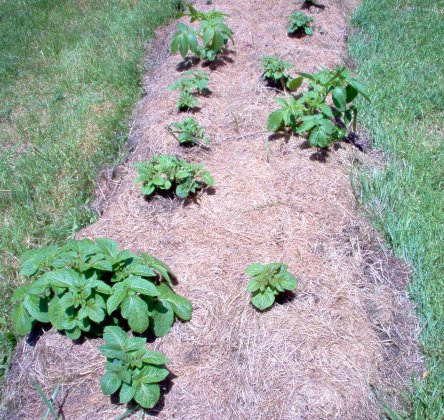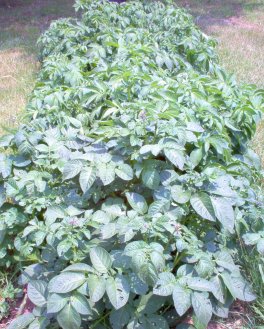|
A guide to self reliant living |
|||||||||||
|
6. Kerosene heaters and cookers
12.
Electrical; generators
Miles Stair's SURVIVAL
Miles Stair's
SURVIVAL |
THE SUSTAINABLE FOOD ECONOMY Since the 1700's, the world's main food crops have been potatoes, cabbage, corn and rice. Potatoes and cabbage fueled the Industrial Revolution. Of the five major food crops, potatoes and cabbage far exceed the others on a per-yield basis per acre. And as important sources of storable protein, vitamins and minerals, potatoes and cabbage easily out-distance the others. Those countries which had the soils and climate - and the attitude - to grow potatoes and cabbage as "fuels" for their populace also had the inventiveness and cleverness to use tools.
Those experts who place the rise of modern society solely upon the use of tools are only half right. The other half of the equation was that they also recognized and cultivated the proper food "fuel." England utilized potatoes for food and grains for highly nutritious ale. Germany utilized cabbage (for kraut) and potatoes as food fuels, and hops and grains for nutritious, storable beer. Russia, somewhat belatedly, brought in millions of Germans to help them produce both potatoes and cabbage to feed their masses, turning the Odessa and Ukraine regions into breadbaskets. North America came to the fore by utilizing all of the food crops, storing massive quantities of same, and utilizing massive acreage of corn and wheat to increase the riches of all of the people. Some types of "fuel" foods can be grown very easily. Potatoes, for example, can be grown on almost any surface, even concrete or asphalt. Old hay in a layer about 6" deep can be spread on the ground in shape, such as 3 foot wide strips (the width of two bales). Potato eyes can then be placed every 1 1/2 feet in two rows down the strip of hay, then covered by about 3" of old hay. When the sprouts are fully leafed out and green, another layer of hay can be laid on top, and that will form another bunch of spuds! Kept watered, the potatoes will grow perfectly even on hardpan or concrete, and be easy to harvest. Even on city lots, several rows of potatoes grown in a back yard will be sufficient to help considerably with self sufficiency.
"Hay bale" gardening can be done by those too weak or physically impaired to dig the soil...just mow the grass close to the ground and lay down some hay. Need to grow some crops other than tubers? Place hay bales on edge, use a hatchet to chop out a small hole, put some potting soil in the hole, and put in transplants or just plant seeds. Cole crops do very well with hay bale gardening. The hay decomposes into very rich compost, improving the soil underneath if it is tilled in when fully decomposed. Just remember to remove the twine from the remains of the hay bales before using a rototiller! Grass from a lawn can be used instead of hay - under certain circumstances only. The lawn must not have been treated with a systemic "weed and feed" fertilizer, of course. The grass should also be allowed to age for several weeks before use, or the heat from using it as "sheet compost" can kill the plants. Used correctly, anybody can grow potatoes with hay or cut grass, almost anywhere, with very little work involved. Potatoes store very easily for a long time, so there is no reason for anyone to go hungry! I actually get better results from grass clippings than with old hay. Those countries or continents which could not comprehend the concepts of tools and bulk food fuels did not advance beyond subsistence levels, and have increased in population only because of importation of food fuels from the more advanced countries. They still don't get the concepts, and probably never will, their very survival depending upon the largess of those with excess to share. The use and development of the honeybee parallels the use of "fuel" foods. Recognizing the importance of honey, beeswax, and free pollination services, the emerging industrial nations "tamed" the wild bee. An American named Langstroth discovered "bee space" and designed the modern hive in 1850. Shortly thereafter, Hoffman, Mehring, and von Hruschka, made possible the economical extraction of honey. Now the great industrial powers are failing, having forgotten their roots: they neither till the soil nor produce durable goods. Flipping burgers and shuffling paper do produce a "service economy," but not a sustainable economy, as nothing of real value is produced! A "service economy" does nothing but consume the products of an earlier era, slowly depreciating the assets of the nation until nothing of value is left. As tillers of the soil we can produce our own food crops, raise our own honeybees, and keep alive the dream of a productive society. Future generations can build upon what we do, the concepts we keep alive, as a basis for a continued future.
ANOTHER VIEW OF CABBAGE, from New England Gardener Cabbage is a very important crop, with high yields of food. It can be eaten raw as Cole Slaw, boiled alone or with carrots, potatoes and ham, stir fried for a nutty flavor, or fermented into sour kraut. It also keeps for months in a root cellar, or it may be canned or dried for indefinite storage. The Fall or Winter varieties are the best keepers. In the South, or coastal areas, you maybe able to grow cabbage over the Winter. Here where I live, we have to start Spring cabbage and broccoli inside, and set out the plants. The Winter keeping varieties are the important ones, and here is how we start ours in the early Summer. We add manure or fertilizer and deeply work the soil with a single tine, only under the row itself. Then we wet the row thoroughly, and plant the seed shallowly.
To save seed, you dig up the entire mature plant, and move it to a small bed, for it's second year of growth, when the seed will develop. Mulch it over the winter to protect it. You can also dig and store the ENTIRE plant, in the root cellar. Some knowledgeable homesteaders claim cabbage keeps best hung upside down with the roots on it, so you can select from the heads which kept the longest this way. I have done that, and it works well, but it also keeps well on the shelf in our root cellar.
|
|
|||||||||




